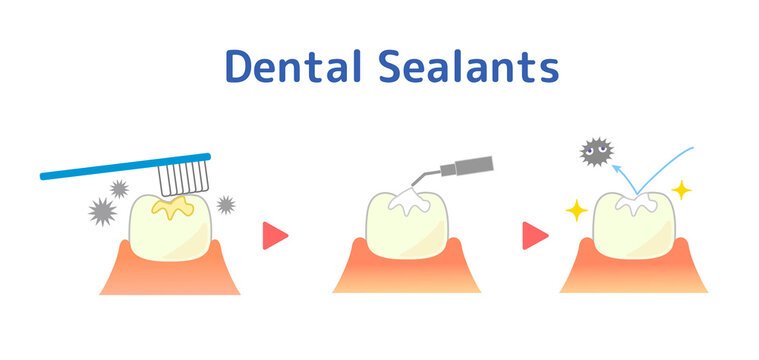+91 891 993 2794
info@tajdental.inTaj Dental: Sealants Shield Teeth

Introduction
In the vast landscape of dental care, Taj Dental emerges as a stalwart defender, wielding a powerful weapon in the form of dental sealants. This article delves into the profound significance of these sealants, unraveling how they stand as a crucial line of defense, safeguarding your precious teeth from potential threats.
Understanding Dental Sealants
What Are Dental Sealants?
Dental sealants, a stalwart in preventive dentistry, are thin protective coatings meticulously applied to the chewing surfaces of molars and premolars. Crafted from plastic material, these sealants act as an impermeable barrier, thwarting the advances of bacteria and acids, ultimately preventing the onset of tooth decay.
The Art of Application
Taj Dental’s mastery in sealant application follows a meticulous process. Teeth undergo a thorough cleaning, ensuring a pristine surface for application. Subsequently, the sealant is expertly painted onto the tooth surface, creating an invisible yet robust shield that fortifies against the ravages of decay.
The Protective Power Unveiled
Decay Prevention
The primary objective of dental sealants is to preclude the development of cavities by obstructing the infiltration of harmful bacteria. Taj Dental adopts a proactive stance, strategically reducing the risk of decay, especially in the vulnerable fissures and crevices of the teeth.
Long-Term Durability
Taj Dental places a premium on the longevity of the sealants applied. This commitment to durability ensures sustained protection, effectively warding off dental decay and sparing individuals the inconvenience of frequent dental interventions.

Advantages Over Traditional Methods
Sealants vs. Fillings
Distinguishing itself from traditional dental approaches, the comparison between sealants and fillings reveals intriguing insights into preventive dentistry, showcasing Taj Dental’s commitment to innovative and patient-centric care.
Proactive Defense with Sealants
Dental sealants, Taj Dental’s formidable defense mechanism, operate on a proactive front. Applied to the chewing surfaces of molars and premolars before decay sets in, sealants act as a preventative shield. They create an impermeable barrier, obstructing bacteria from infiltrating the vulnerable pits and fissures of the teeth. This approach significantly reduces the risk of cavities, addressing the root cause before it evolves into a dental concern.
Reactive Nature of Fillings
Conversely, traditional fillings come into play after cavities have already formed. These restorative interventions involve removing the decayed portion of the tooth and filling the cavity with materials like amalgam or composite resin. While effective in treating existing dental issues, fillings lack the preemptive nature of sealants. They are reactive solutions, addressing problems that have already manifested.
Minimally Invasive Application
Sealants take the spotlight for their non-invasive application. The process involves cleaning the teeth thoroughly, followed by the expert application of the sealant material. This seamless and painless procedure ensures minimal disruption to the natural tooth structure. Taj Dental’s commitment to patient comfort aligns perfectly with this aspect of sealant application.
Invasive Nature of Fillings
On the other hand, traditional fillings require the removal of the decayed portion of the tooth, resulting in a more invasive procedure. This process involves shaping the tooth to accommodate the filling material, potentially leading to discomfort and sensitivity. Taj Dental recognizes the importance of minimizing such discomfort, and this consideration is reflected in their preference for the non-invasive nature of sealants.
Aesthetic Appeal
Another noteworthy distinction lies in the aesthetic aspect. Dental sealants are virtually invisible, seamlessly blending with the natural tooth color. This makes them an appealing choice, especially for individuals conscious of the cosmetic aspect of dental care. In contrast, traditional fillings, often made of noticeable materials like silver amalgam, can impact the visual appeal of the smile.
Long-Term Prevention vs. Reactive Solutions
Taj Dental’s preference for sealants echoes their commitment to long-term prevention. By proactively applying sealants to at-risk teeth, they create a durable shield against potential decay, addressing the issue before it escalates. Traditional fillings, while effective in treating existing cavities, fall short in the realm of long-term prevention.
Non-Invasive Protection
In a bid to prioritize patient comfort, sealants offer a non-invasive alternative to conventional dental procedures. Taj Dental’s commitment to minimizing discomfort aligns seamlessly with the application of sealants, ensuring a pain-free experience for patients.
Taj Dental’s Approach to Comprehensive Care
Customized Sealant Plans
Recognizing the uniqueness of each patient’s oral health, Taj Dental tailors sealant plans accordingly. This personalized approach enhances the effectiveness of the sealants, addressing specific vulnerabilities and ensuring a bespoke shield against decay.
Regular Monitoring and Maintenance
Taj Dental’s commitment to patient care extends beyond the initial application. Regular check-ups are emphasized to monitor the condition of sealants, ensuring they continue to provide optimal protection throughout the years.
A Smile-Saving Investment
Cost-Effective Prevention
Investing in dental sealants proves to be a judicious and cost-effective strategy. Taj Dental advocates for preventative measures, underscoring that the upfront cost of sealants is significantly outweighed by potential expenses associated with untreated cavities.
Insurance Coverage
Collaborating with various insurance providers, Taj Dental recognizes the importance of accessible dental care. Many insurance plans cover the cost of dental sealants, making them a practical and beneficial option for patients seeking comprehensive dental protection.
Conclusion
In the realm of oral health, Taj Dental’s commitment to preventive care through dental sealants shines brightly. This proactive approach not only preserves smiles but also establishes a lasting, healthy foundation for overall well-being.
FAQs
1. How long do dental sealants last?
Dental sealants can last up to 10 years with proper care and maintenance.
2. Are dental sealants suitable for adults?
While commonly applied to children, adults with susceptible teeth can also benefit from dental sealants.
3. Do sealants interfere with daily activities like eating?
No, dental sealants are thin and do not affect normal activities, including eating.
4. Can sealants be applied to all teeth?
Sealants are typically applied to molars and premolars, as they have deep grooves prone to trapping food particles.
5. Are there any side effects of dental sealants?
In rare cases, individuals may experience an allergic reaction, but this is uncommon, and the benefits far outweigh the risks.

Leave A Comment